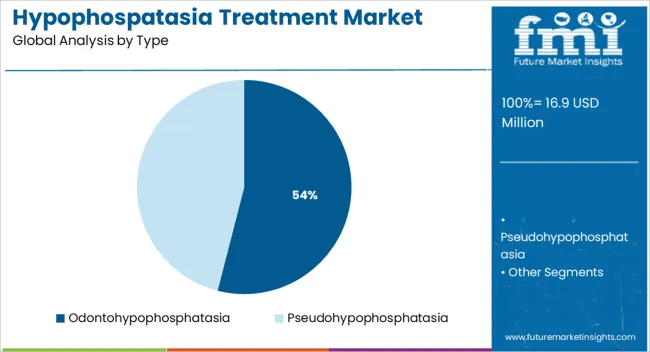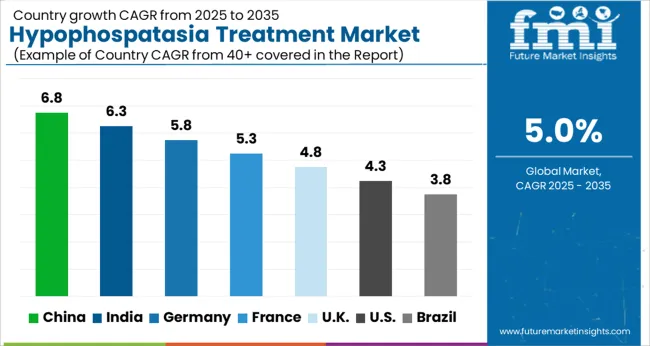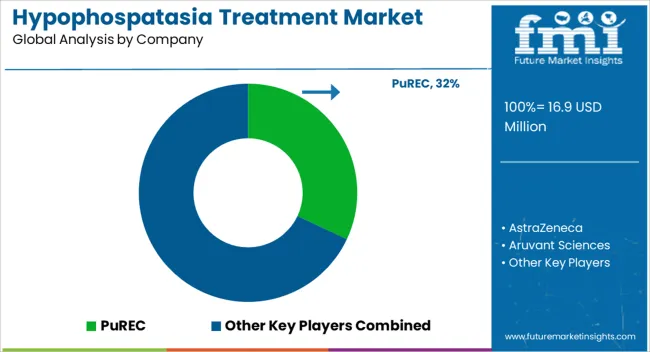The Hypophospatasia Treatment Market is estimated to be valued at USD 16.9 million in 2025 and is projected to reach USD 27.6 million by 2035, registering a compound annual growth rate (CAGR) of 5.0% over the forecast period.

| Metric | Value |
|---|---|
| Hypophospatasia Treatment Market Estimated Value in (2025 E) | USD 16.9 million |
| Hypophospatasia Treatment Market Forecast Value in (2035 F) | USD 27.6 million |
| Forecast CAGR (2025 to 2035) | 5.0% |
The Hypophosphatasia Treatment market is witnessing steady development supported by increasing awareness, early diagnosis capabilities, and a growing patient population affected by rare metabolic disorders. The market’s momentum is being strengthened by innovations in enzyme replacement therapies, as well as strategic focus by pharmaceutical companies on orphan drug development. Regulatory incentives such as extended exclusivity and funding support have further encouraged research in this domain.
As highlighted in clinical publications and company disclosures, advancements in genetic screening and prenatal diagnostics are contributing to earlier detection and timely intervention. Growth prospects are also being shaped by collaborations between research institutions and biopharma firms aimed at improving therapeutic protocols.
Furthermore, efforts by patient advocacy groups and healthcare authorities to improve accessibility to rare disease treatments are expected to play a significant role in driving adoption With continued research and support infrastructure development, the market is expected to evolve with increasing treatment adherence and patient engagement.
The market is segmented by Type, Treatment Type, and End User and region. By Type, the market is divided into Odontohypophosphatasia and Pseudohypophosphatasia. In terms of Treatment Type, the market is classified into Medication. Based on End User, the market is segmented into Hospitals, Pharmacies, and Others. Regionally, the market is classified into North America, Latin America, Western Europe, Eastern Europe, Balkan & Baltic Countries, Russia & Belarus, Central Asia, East Asia, South Asia & Pacific, and the Middle East & Africa.

The odontohypophosphatasia type segment is anticipated to account for 54.0% of the Hypophosphatasia Treatment market revenue share in 2025, making it the most prominent type. This dominance is being attributed to the comparatively higher prevalence of this milder form of the disease and its tendency to remain undiagnosed until dental abnormalities emerge.
Clinical publications have emphasized the need for early dental evaluation as a diagnostic pathway, leading to increased detection of this specific subtype. The segment's growth has been supported by growing awareness among dental professionals and pediatricians, enabling timely referral and diagnosis.
Additionally, treatment responsiveness in this subtype has shown favorable outcomes, encouraging healthcare providers to recommend intervention at earlier stages As patient registries expand and genetic insights become more accessible, the segment is projected to maintain its lead due to the comparatively higher patient volume and consistent therapeutic needs associated with dental manifestations.
The medication segment is projected to capture 72.5% of the Hypophosphatasia Treatment market revenue share in 2025, establishing it as the leading treatment approach. The segment's dominance has been influenced by the widespread adoption of enzyme replacement therapy, particularly asfotase alfa, which has demonstrated clinical effectiveness in improving skeletal development and survival in affected patients.
Investor updates and therapeutic pipeline reports have highlighted the medication's approval in multiple regions and its expanding availability through specialty pharmacies. Treatment protocols involving medication have been standardized in clinical practice guidelines, reinforcing their use across patient demographics.
The preference for pharmacological treatment over surgical or supportive interventions has also been reinforced by regulatory support and insurance reimbursement structures These factors, combined with positive patient outcomes and increased prescribing by metabolic specialists, are expected to sustain the segment’s leadership in the coming years.

The hospitals segment is forecasted to account for 64.0% of the Hypophosphatasia Treatment market revenue share in 2025, holding the top position among end users. The dominance of hospitals has been driven by their ability to offer comprehensive diagnostic services, multidisciplinary treatment plans, and access to specialty care required for managing rare metabolic disorders.
Hospitals have been central to the initiation and monitoring of enzyme replacement therapies, which often require intravenous administration and regular clinical assessments. Clinical care networks and academic medical centers have also played a significant role in consolidating hospital-based treatment protocols.
Additionally, hospitals have received growing institutional support and funding for rare disease programs, enabling infrastructure development tailored to these complex cases As a result, patients with hypophosphatasia are more frequently referred to hospital settings for advanced evaluation and ongoing therapy, reinforcing this segment's continued leadership in the overall market.
The global demand for hypophosphatasia treatment is projected to increase at a CAGR of 5.0% during the forecast period between 2025 and 2035, reaching a total of USD 27.6 Million in 2035, according to a report from Future Market Insights (FMI). From 2020 to 2025, sales witnessed significant growth, registering a CAGR of 2.6%. According to Future Market Insights, a market research and competitive intelligence provider, the Hypophosphatasia Treatment market was valued at USD 16.9 Million in 2025.
As per the statistics published by the National Organization for Rare Disorders, Inc., there is an estimated annual incidence of hypophosphatasia is 1 in every 100,000 births in Canada. Factors such as the growing special designation from the regulatory authorities for the treatment of hypophosphatasia, coupled with the high demand for novel treatment are anticipated to boost the growth of the hypophosphatasia market over the analysis period.
Moreover, the increase in the demand for disease-specific novel treatment is another key factor that is projected to escalate the market growth in the coming years. In addition, huge financial support to the researchers for developing novel interventions is expected to augment the market growth in the near future. Also, the surge in special designation from the regulatory authorities to offer treatment to patients as quickly as possible is propelling the revenue share of the hypophosphatasia treatment market.
Family History of Hypophosphatasia to Fuel the Market Growth
The severe perinatal and infantile forms of hypophosphatasia are inherited as autosomal recessive conditions. The patient receives one defective gene from each parent. Some more mild (childhood or adult) hypophosphatasia cases are also inherited this way. Other mild adult as well as odontohypophospatasia cases seem to be inherited in an autosomal dominant pattern (the patient gets just one defective gene, not two, transmitted from one of his/her parents).
In this form, mild hypophosphatasia can occur from generation to generation. The perinatal form of hypophosphatasia can often be detected during pregnancy by ultrasound and by measuring ALP activity in chorionic villus samples from amniocentesis. Individuals with hypophosphatasia and parents of children with hypophosphatasia are encouraged to seek genetic counseling to explain the likelihood and severity of hypophosphatasia recurring in their families. This is a major factor that is projected to boost the growth of the market during the forecast period.
Rise in Prevalence of Hypophosphatasia to Accelerate the Market Growth
The rising incidence of genetic disorders characterized by the abnormal development of bones and teeth leads to Hypophosphatasia. These abnormalities occur due to defective mineralization such as calcium and phosphorus. These minerals are required for proper hardness as well as strength. Defective mineralization results in bones becoming soft and more prone to fracture.
Hypophosphatasia symptoms can vary greatly from one person to another, sometimes even among members of the same family. The disease is caused by mutations in the tissue nonspecific alkaline phosphatase (ALPL) gene, which is also known as the TNSALP gene. Such mutations lead to low activity of the tissue nonspecific alkaline phosphatase enzyme. Depending on the specific form, HPP can be inherited in an autosomal recessive or autosomal dominant manner. Thus, this is another major factor that is anticipated to fuel market growth in the forthcoming years.
Patent Expiration of Major Brands to Restrain the Market Growth
Limited operating revenue opportunities for research and development of targeted therapies by many pharmaceuticals is one of the major factors that is expected to hamper the growth of the Hypophosphatasia Treatment Market during the forecast period.
Moreover, the patent expiration of major brands, coupled with the low healthcare budget in some developing regions will also impede market growth in the near future.
Fewer Treatment Options to Limit the Market Growth
Lack of skilled professionals or trained expertise in this area, in low-and-middle class economies, will hinder the way of market growth over the analysis period. In addition, factors including fewer treatment options available are likely to limit the growth of the hypophosphatasia treatment market in the coming years.

Increase in R&D Proficiencies in the Region to Fuel the Market Growth
The hypophosphatasia treatment market in North America is expected to accumulate the highest market share of 46% in 2025. Factors such as increasing research & development activities from major market players, and an increase in product offerings, are anticipated to fuel the regional market growth over the analysis period.
In addition, greater affordability, coupled with an increase in demand for early treatment are other major factors that will propel the Hypophosphatasia treatment market in North America in the coming years. The region is expected to hold the highest CAGR of 4.9% during the forecast period.
Growing Demand for Hypophosphatasia Treatment in the Region to Fuel the Market Growth
The hypophosphatasia treatment market in Asia Pacific is expected to accumulate the highest market share of 44% in 2025. The Asia Pacific hypophosphatasia market is anticipated to register significant growth during the analysis period, attributed to factors such as an increase in the adoption of new products, and a rise in demand for hypophosphatasia treatment in emerging countries such as India and China.
Additionally, other factors including increasing awareness about the disease will also propel the market growth in Asia Pacific in the near future. The region is expected to hold the highest CAGR of 4.8% during the forecast period.
Odontohypophospatasia Segment to beat Competition in Untiring Market
On the basis of type, the global Hypophosphatasia Treatment market is dominated by the Odontohypophospatasia Segment, which accounts for a share of 48%. The segment is expected to hold a CAGR of 4.9% over the analysis period.
The high segment’s growth is attributed to factors such as a high number of patients with odontoid hypophosphatasia, which is characterized by loss of premature teeth in childhood or loss of teeth in adulthood.
Medication Segment to Drive the Hypophosphatasia Treatment Market
Based on treatment type, the medication segment is expected to witness a significant growth of 47% in 2025, and the trend is expected to continue during the forecast period, expanding at a rapid rate of 4.8% CAGR over the analysis period.
This growth is attributed to the launch of products for the treatment of hypophosphatasia from major manufacturers. For instance, in 2020, the USA Food and Drug Administration (FDA) approved Strensiq (asfotase alfa) as the first approved medical treatment for infantile, perinatal, and juvenile-onset HPP.
Hospital Pharmacies Segment to Drive the Hypophosphatasia Treatment Market
Based on the Distribution Channel, the hospital pharmacies segment is expected to witness a significant growth of 46% in 2025, and the trend is expected to continue during the forecast period, expanding at a 4.7% CAGR over the analysis period.
The segment’s significant growth is attributed to the fact that most of the major hypophosphatasia treatment products are prescription products, which are available in hospital pharmacies.

Hypophosphatasia Treatment Market startup players are adopting various marketing strategies such as new product launches, geographical expansion, mergers and acquisitions, partnerships, and collaboration to identify the interest of potential patients and create a larger customer base.
Prominent players in the hypophosphatasia treatment market are Kirin Holdings Company, Vericel Corporation, Mereo BioPharma Group plc., Novartis AG, AM-Pharma B.V., Alexion, Bayer AG, Enobia Pharma, and Pfizer, Inc., among others.
Recent Developments:
| Report Attribute | Details |
|---|---|
| Growth Rate | CAGR of 5.0% from 2025 to 2035 |
| Market Value in 2025 | USD 16.9 million |
| Market Value in 2035 | USD 27.6 million |
| Base Year for Estimation | 2025 |
| Historical Data | 2020 to 2025 |
| Forecast Period | 2025 to 2035 |
| Quantitative Units | Revenue in USD Million and CAGR from 2025 to 2035 |
| Report Coverage | Revenue Forecast, Company Ranking, Competitive Landscape, Growth Factors, Trends, and Pricing Analysis |
| Segments Covered | Type, Treatment Type, End User, Region |
| Regions Covered | North America; Western Europe; Eastern Europe; Asia Pacific; Latin America; Middle East & Africa (MEA) |
| Key Countries Profiled | The USA, Canada, Brazil, Mexico, BENELUX, Germany, The UK, France, Spain, Italy, Nordics, Poland, Russia, India, Malaysia, Singapore, Thailand, Australia, New Zealand, GCC, South Africa, Israel |
| Key Companies Profiled | PuREC; AstraZeneca; Aruvant Sciences; AM-Pharma; Railybio; Biometrix; Cook Medical; Grena; Redax; Lung Therapeutics Inc. |
| Customization & Pricing | Available upon Request |
The global hypophospatasia treatment market is estimated to be valued at USD 16.9 million in 2025.
The market size for the hypophospatasia treatment market is projected to reach USD 27.6 million by 2035.
The hypophospatasia treatment market is expected to grow at a 5.0% CAGR between 2025 and 2035.
The key product types in hypophospatasia treatment market are odontohypophosphatasia and pseudohypophosphatasia.
In terms of treatment type, medication segment to command 72.5% share in the hypophospatasia treatment market in 2025.






Full Research Suite comprises of:
Market outlook & trends analysis
Interviews & case studies
Strategic recommendations
Vendor profiles & capabilities analysis
5-year forecasts
8 regions and 60+ country-level data splits
Market segment data splits
12 months of continuous data updates
DELIVERED AS:
PDF EXCEL ONLINE
Treatment-Resistant Hypertension Management Market Size and Share Forecast Outlook 2025 to 2035
Treatment-Resistant Depression Treatment Market Size and Share Forecast Outlook 2025 to 2035
Treatment Pumps Market Insights Growth & Demand Forecast 2025 to 2035
Pretreatment Coatings Market Size and Share Forecast Outlook 2025 to 2035
Air Treatment Ozone Generator Market Size and Share Forecast Outlook 2025 to 2035
CNS Treatment and Therapy Market Insights - Trends & Growth Forecast 2025 to 2035
Seed Treatment Materials Market Size and Share Forecast Outlook 2025 to 2035
Acne Treatment Solutions Market Size and Share Forecast Outlook 2025 to 2035
Scar Treatment Market Overview - Growth & Demand Forecast 2025 to 2035
Soil Treatment Chemicals Market
Water Treatment System Market Size and Share Forecast Outlook 2025 to 2035
Water Treatment Chemical Market Size and Share Forecast Outlook 2025 to 2035
Algae Treatment Chemical Market Forecast and Outlook 2025 to 2035
Water Treatment Market Size and Share Forecast Outlook 2025 to 2035
Water Treatment Ozone Generator Market Size and Share Forecast Outlook 2025 to 2035
Water Treatment Equipment Market Size and Share Forecast Outlook 2025 to 2035
Burns Treatment Market Overview – Growth, Demand & Forecast 2025 to 2035
CRBSI Treatment Market Insights - Growth, Trends & Forecast 2025 to 2035
Water Treatment Polymers Market Growth & Demand 2025 to 2035
Asthma Treatment Market Forecast and Outlook 2025 to 2035

Thank you!
You will receive an email from our Business Development Manager. Please be sure to check your SPAM/JUNK folder too.
Chat With
MaRIA